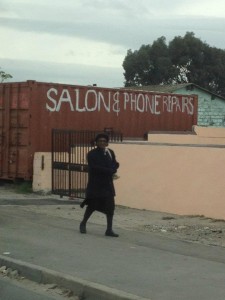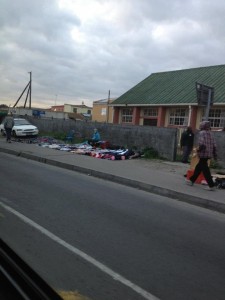Ahh the minibus. How I will miss the sounds of strange men screaming “Wyberg??” at me as I walk down Main Street once I get back.
Introductions
Well let’s start from the beginning, what is a minibus? For those without their own set of wheels, it is the most affordable mode of transportation in Cape Town. Although there is much competition, which includes: cabs, the bus, the train, or walking. The minibus, unlike cabs, trains and other modes of transportation, usually includes someone screaming out the window at you, a trust payment system, and mainly a lot of people squeezing into a van. While I usually take the train to work, just three weeks back, I took a work related trip – as my opportunity to use the minibus system on my own.
Here is my story
Since I have a weekly train pass, I first took the train to Wynberg, a bustling station surrounded by malls and shops, busy passersby’s, sidewalk vendors, and office buildings. I walk towards the Minibus hub where 15-20 minibuses lined up for the chance to take customers to their desired destinations. Each row touting the name of the minibus’s route: Cape Town, Hout Bay, Fish Hoek, etc. I go for Hout Bay. I climb into the first van that looks loaded up and jump in. Where’s the driver? I don’t know, hopefully coming soon. I am I for sure going to Hout Bay? I hope so, trusting the sign. How much is it? No idea. So about 5 minutes later, with a full van, we are moving!
It soon becomes clear by the fact I am so eager to pay once I get into the minibus, that I am newbie. A local Xhosa woman tells me she will let me know when to pay. And when we finally do, everyone hands up his or her money. It passes through several hands as it moves to the front (where the driver is). And for those who need change, the money makes it back to their owners.
Minutes after paying, our already full van, makes a stop and picks up 3 more men. The limit is 16 people per van, but eh rules are meant to be broken. They squeeze into the van, leaving me with only room for one thigh. I soon have two choices: hold one thigh in the air or place over the leg of the women next to me. She’s nice and lets me. We then make a stop to let someone else off, which you do by yelling out what street you want to get off at, when nearby.
Unfortunately I have never been to the Hout area and find this tricky. Thankfully once again the same lady helps me. We then make another stop, this time the door comes off the hinges. Me and the other guy nearest to the door exchange glances and move further inland. We make another stop. This time picking up and letting people off at a local township. In this mountainside township, within 20 walking distances of the beach, there is an array of colorful formal and informal houses. Children are just getting off school and wondering home, while adults both active and idle float around the mini town.
Finally, the helpful lady screams out my stop, we are close. How close, I really had no idea, since she couldn’t understand my pronunciation of the cross street, but with faith in my heart, I jump out.
Want to know more about the minibus. Check out these three videos!
https://vimeo.com/16401814
Wish I had saw this video first weeks in SA!
http://www.youtube.com/watch?v=DSV3ayji9UY
An introduction to the Minibus
http://www.youtube.com/watch?v=hsWerywXKBA
A minibus prank








